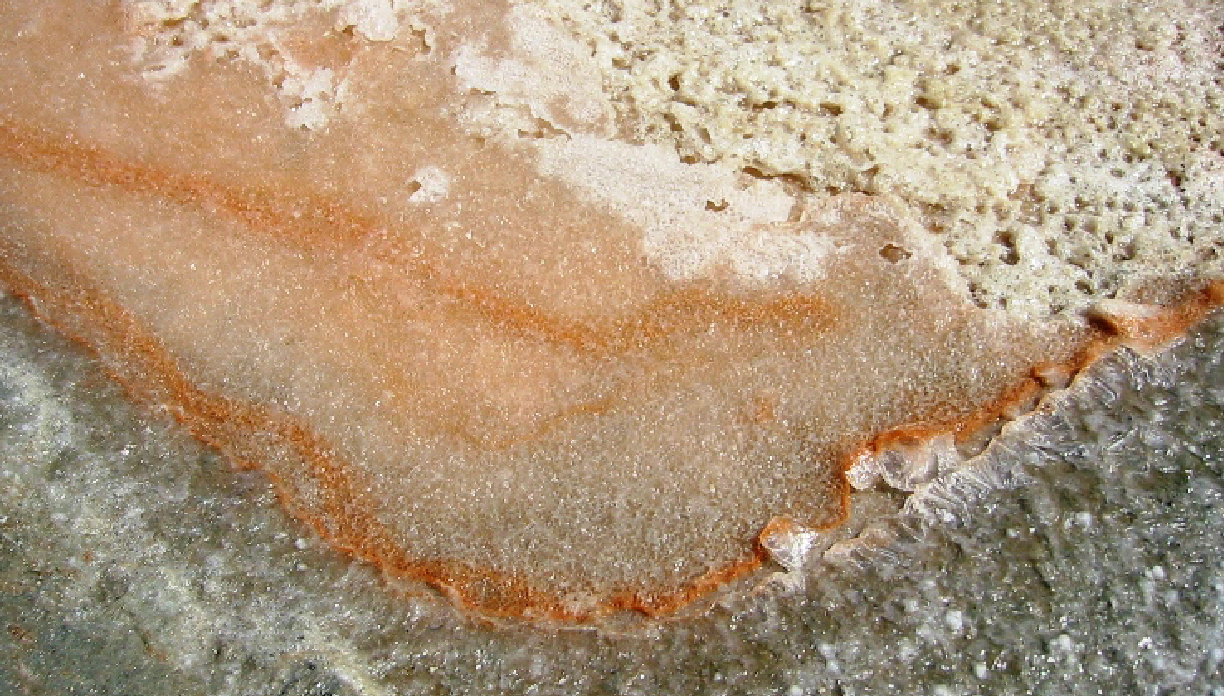Functional and Systems Biology
How Some Algae Thrive in Harsh, Low-Iron Environments
A team of researchers documented complete genomes, transcriptomes, and proteomes, and several iron-uptake strategies for two species of Dunaliella algae that need little iron to survive.

A multi-institutional team of scientists successfully produced complete genomes, transcriptomes, and proteomes and identified iron-uptake strategies for two species of Dunaliella, a type of algae that can survive in inhospitable environments such as salt flats where available iron is very low. (Photo courtesy of Wikipedia Commons )
The Science
Algae play a huge global role in the uptake of carbon dioxide via photosynthesis in marine environments, representing an important target for climate crisis mitigation efforts. Productivity of most algal photosynthesis efforts is limited by the availability of iron in Earth’s oceans. A particular type of algae called Dunaliella, however, thrives in low-iron environments. A multi-institutional team of researchers recently produced complete genomes, transcriptomes, and proteomes for two species of Dunaliella from two different but iron-limited environments. Additionally, they identified dozens of genes and multiple complementary strategies for iron uptake and management for the two algal types. The team’s insights can be applied to a variety of fields, ranging from climate change mitigation to the development of future bioproducts, including biofuels.
The Impact
Marine algae are responsible for half of the world’s primary productivity—the rate at which energy is converted to organic substances by photosynthesis. They also offer huge potential as a biomass option for biofuels and other bioproducts development. But due to insufficient iron levels in one third of Earth’s oceans, algal productivity is limited. Characterizing how these two species of algae thrive in a harsh environment with little available iron lends important foundational insights into climate mitigation strategies and bioproducts development.
Summary
A multi-institutional team of scientists employed a multi-omics strategy to understand how two types of Dunaliella algae (Dunaliella tertiolecta and Dunaliella salina Bardawil) thrive in extreme conditions where iron availability is very low. Dunaliella tertiolecta is commonly found in coastal sea waters worldwide. Dunaliella salina Bardawil is found in hypersaline environments and salt flats. Both are used to produce a range of bioproducts, including biofuels. Using a variety of techniques, the team generated high-quality, chromosome-scale genome assemblies and transcriptomes for both species. They used this resource to identify key proteins that allow both species to thrive in low-iron and other harsh conditions. These proteins include a massive expansion of transferrin proteins, which bind and transport iron into the cell, and a unique family of siderophore-uptake proteins whose general purpose is to facilitate the import of scavenged iron into the cell. Among the findings, the team determined that the two species could replace ferredoxin, a type of iron- and sulfur-containing protein, with a flavodoxin, which being iron-independent, meant that both species could reduce their need for iron by at least 6%. Proteomic analysis of the two species also revealed that Dunaliella responds to low-iron conditions with reduced investment in the photosynthetic apparatus coupled with remodeling of antenna proteins, most notably by the dramatic induction of a novel protein called TIDI1. The team’s insights into the genetic and biochemical processes involved in these algae species and their iron-uptake mechanisms provide a solid foundation for continuing discoveries on extremophilic algae. These discoveries lend important insights into combating climate change and in the development of next-generation bioproducts and biofuels.
Contacts
Lital Davidi, University of California, Los Angeles, davidi.lital70@gmail.com
Sean D. Gallaher, University of California, Los Angeles | University of California, Berkeley, s@gallaher.me
Samuel O. Purvine, EMSL, samuel.purvine@pnnl.gov
Sabeeha S. Merchant, University of California, Los Angeles | University of California, Berkeley, sabeeha@berkeley.edu
Funding
The project was supported by a Department of Energy (DOE), Office of Science, Basic Energy Sciences program award. Proteomics analyses were supported by a project award from the Environmental Molecular Sciences Laboratory, a DOE, Office of Science user facility sponsored by the Biological and Environmental Research program.
Publication
L. Davidi, et al. “Pumping iron: A multi-omics analysis of two extremophilic algae reveals iron economy management.” Proceedings of the National Academy of Sciences 120 (30) e2305495120. (2023) [DOI: 10.1073/pnas.2305495120]

